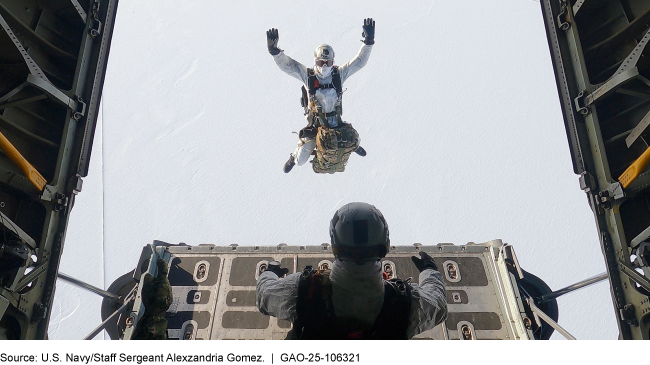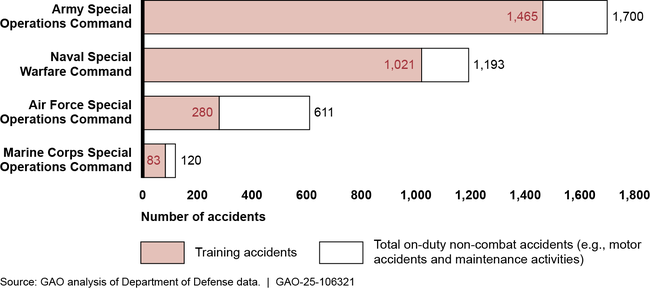Special Operations Forces: Additional Oversight Could Help Mitigate High-Risk Training Accidents
Fast Facts
Special Forces personnel conduct high-risk training to prepare for challenging missions. But serious accidents have raised questions about the safety of some of these activities.
About 80% of the over 3,600 on-duty, non-combat accidents reported from FY 2012-2022 occurred during training. Parachute and dive training accounted for about 40% of those accidents.
The U.S. Special Operations Command designated 7 training areas as high-risk, including parachuting, diving, and urban combat. But it hasn't analyzed accident trends in these areas or others that may be high-risk to improve safety.
Our recommendations address this and more.

Highlights
What GAO Found
About 80 percent of the over 3,600 reported on-duty, non-combat accidents involving special operations forces (SOF) personnel occurred during training activities in fiscal years 2012 through 2022, according to military service safety center data. About 40 percent of the total reported training accidents occurred in two high-risk training areas, parachute training and combat dive training. Also, the data show that over 80 percent of training accidents were reported as due to human error. Factors that were commonly present and contributed to these accidents included failure to adhere to training standards and complacency.
Reported Number of On-Duty, Non-Combat and Training Accidents involving Special Operations Forces Personnel, Fiscal Years 2012-2022

Note: Active-duty personnel (approximate): Army: 36,000; Navy: 11,000; Air Force: 17,000; Marine Corps: 3,500.
U.S. Special Operations Command (SOCOM) established a formal program to oversee SOF high-risk training to increase standardization and help mitigate risk. The command designated seven training areas as high risk in 2022 but has not analyzed accident trends in those training areas nor in other areas that could be high risk, according to officials. As a result, SOCOM may miss an increase in issues related to safety within training programs that are not already designated high risk. Further, SOCOM has not fully implemented a key oversight component of its formal program that standardizes SOF training activities to help mitigate risk. SOCOM plans to expand the program's scope, but the command has not reevaluated its ability to accomplish an expansion and identify resources for this program. As a result, SOCOM is not positioned to ensure that the SOF service components are mitigating safety risks in their high-risk training programs.
GAO found that the four SOF service components varied in addressing SOCOM's seven oversight requirements for high-risk training in their respective policies. But none fully addressed all seven or had established milestones to do so. By not establishing milestones for the SOF service components, SOCOM does not have reasonable assurance of an effective approach to safety with standardized oversight across the service components to mitigate training risks.
Why GAO Did This Study
SOF personnel prepare to accomplish challenging missions by performing high-risk training activities. However, serious accidents involving SOF personnel have raised questions about the safety of these activities.
Senate Report 117-130 includes a provision for GAO to review SOF training accidents. This report examines trends from fiscal years 2012 through 2022 in reported on-duty, non-combat accidents, including training accidents, involving SOF personnel. The report also describes GAO's assessment of the extent to which (1) SOCOM has developed an approach to effectively oversee SOF high-risk training, and (2) the SOF service components have addressed SOCOM's oversight requirements for high-risk training.
GAO analyzed accident data from fiscal years 2012 through 2022; reviewed training, risk management, and safety documents; and interviewed officials.
Recommendations
GAO is making six recommendations including that SOCOM analyze safety data to identify high-risk training areas, re-evaluate its training assessment program, and establish milestones for the four SOF service component commands to complete updates to their policies that include SOCOM's high-risk training oversight requirements. DOD agreed with the recommendations.
Recommendations for Executive Action
| Agency Affected | Recommendation | Status |
|---|---|---|
| Department of Defense | The Secretary of Defense should ensure that the Commander, U.S. Special Operations Command, performs analyses of negative safety trends when designating SOF high-risk training areas in future updates to its training directive. (Recommendation 1) |
When we confirm what actions the agency has taken in response to this recommendation, we will provide updated information.
|
| Department of Defense | The Secretary of Defense should ensure the Commander, U.S. Special Operations Command, in consultation with the Assistant Secretary of Defense for Special Operations and Low-Intensity Conflict, reevaluates the training assessment program to determine the number of assessments, observations, and inspections of SOF service component commands and the related resources that are needed to achieve the goals of the program. (Recommendation 2) |
When we confirm what actions the agency has taken in response to this recommendation, we will provide updated information.
|
| Department of Defense | The Secretary of Defense should ensure that the Commander, U.S. Special Operations Command, establishes milestones for the U.S. Army Special Operations Command to complete updates to its high-risk training policy that include SOCOM's high-risk training oversight requirements. (Recommendation 3) |
When we confirm what actions the agency has taken in response to this recommendation, we will provide updated information.
|
| Department of Defense | The Secretary of Defense should ensure that the Commander, U.S. Special Operations Command establishes milestones for the U.S. Naval Special Warfare Command to complete updates to its high-risk training policy that include SOCOM's high-risk training oversight requirements. (Recommendation 4) |
When we confirm what actions the agency has taken in response to this recommendation, we will provide updated information.
|
| Department of Defense | The Secretary of Defense should ensure that the Commander, U.S. Special Operations Command establishes milestones for the U.S. Marine Corps Special Operations Command to complete updates to its high-risk training policy that include SOCOM's high-risk training oversight requirements. (Recommendation 5) |
When we confirm what actions the agency has taken in response to this recommendation, we will provide updated information.
|
| Department of Defense | The Secretary of Defense should ensure that the Commander, U.S. Special Operations Command establishes milestones for the U.S. Air Force Special Operations Command to complete updates to its high-risk training policy that include SOCOM's high-risk training oversight requirements. (Recommendation 6) |
When we confirm what actions the agency has taken in response to this recommendation, we will provide updated information.
|
